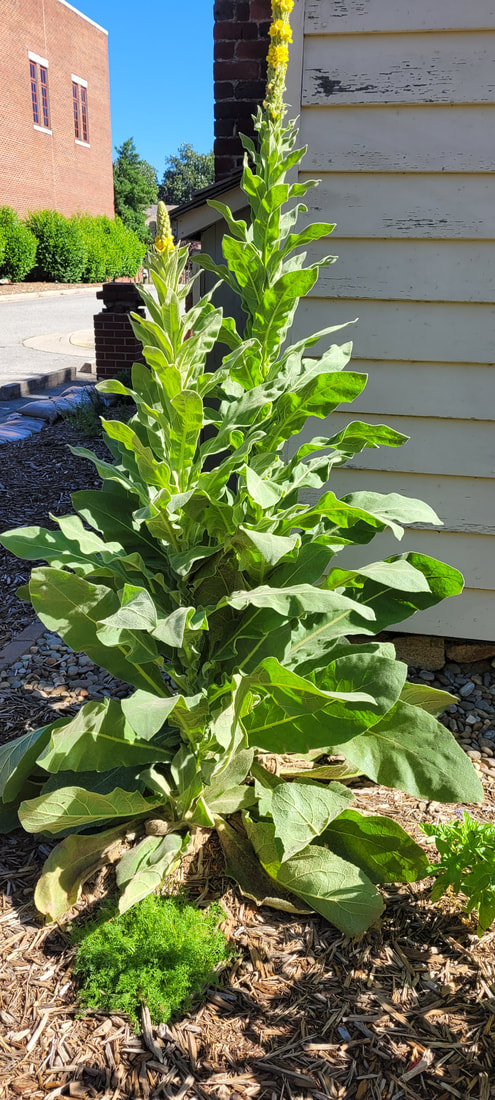NC Unit Herb of the Month...
 Traveling along a highway in June. Traveling along a highway in June.
CLICK HERE FOR MORE INFORMATION ON HERBS:
Garden Design Drought Tolerant Plants and Climate Change Recipes Books Recommendations |
Mullein, Verbascum thapsus.
Why is Mullein in the Greensboro History Museum garden? It is not a native plant and it can be an aggressive grower (a single plant can produce a quarter of a million seeds!). Good questions that I also had to ask. My knowledge of Mullein is primarily from observing its advance across the landscape. It makes a beautiful picture when driving along a highway, and birds and bees certainly appreciate it. The only other thing I knew about it was that the large fuzzy, velvety leaves were used for warmth and comfort in the bottoms of shoes, and were also used to "bandage" wounds. As a useful plant, it may have made its way to our shores as little packets of seeds tucked into the luggage of those making their way to a new country. Others feel sure that the seed arrived as ballast in the bottom of ships that was thrown ashore when ships were unloaded. However it happened, the seeds found soil and climate that they liked and began their spread across the country. There are uses for the plant beyond those mentioned above, including its use as a cosmetic as far back as ancient Rome. Women learned that an infusion of the yellow flowers highlighted blond hair. Dioscorides, the first century physician, botanist, and pharmacologist, used the roots to treat various ailments. Pliny the Elder used the leaves to treat lung problems. Gout and hemorrhoids were also treated with Mullein, along with cramps, convulsions, toothaches, tumors, irritated skin and many other problems. A virtual medicine chest in a plant. It soon made its way to England and Germany, and then to this country. Colonists were not the only one to find the plant helpful. Native Americans mixed the dried leaves with their own tobacco blend to treat sore throats and "mental disturbances." They also used it as a soak for sprains and ai infusion of the leaves to treat pneumonia. The plant does contain mucilage (an emollient), and works as an astringent, diuretic, and expectorant. Proponents claim the entire plant helps as a sedative, and it has been used for migraines. The Herb Society of America, Inc. does not encourage the medicinal use of plants without the knowledge and assistance of a physician. Many plants do have components useful medicinally, but only for specific illnesses; they can also interfere with medications you may currently be taking. Many can also be dangerous. |
We Would Love to Have You Visit!
|
|
LIMITED Permission to Use Materials
The right to download and store or output the materials on our website is granted for the user's personal educational use only. Materials are copyrighted may not be edited, reproduced, transmitted or displayed by any means mechanical or electronic without our express written permission. Users wishing to obtain permission to reprint or reproduce any materials appearing on this site may contact us using the Contact Form. If granted, we will email you a written permission for you to keep on file. We respond quickly to such requests. |
ASSOCIATION
The North Carolina Unit is a member of the Herb Society of America, Inc. Visit the national organization at www.herbsociety.org |

